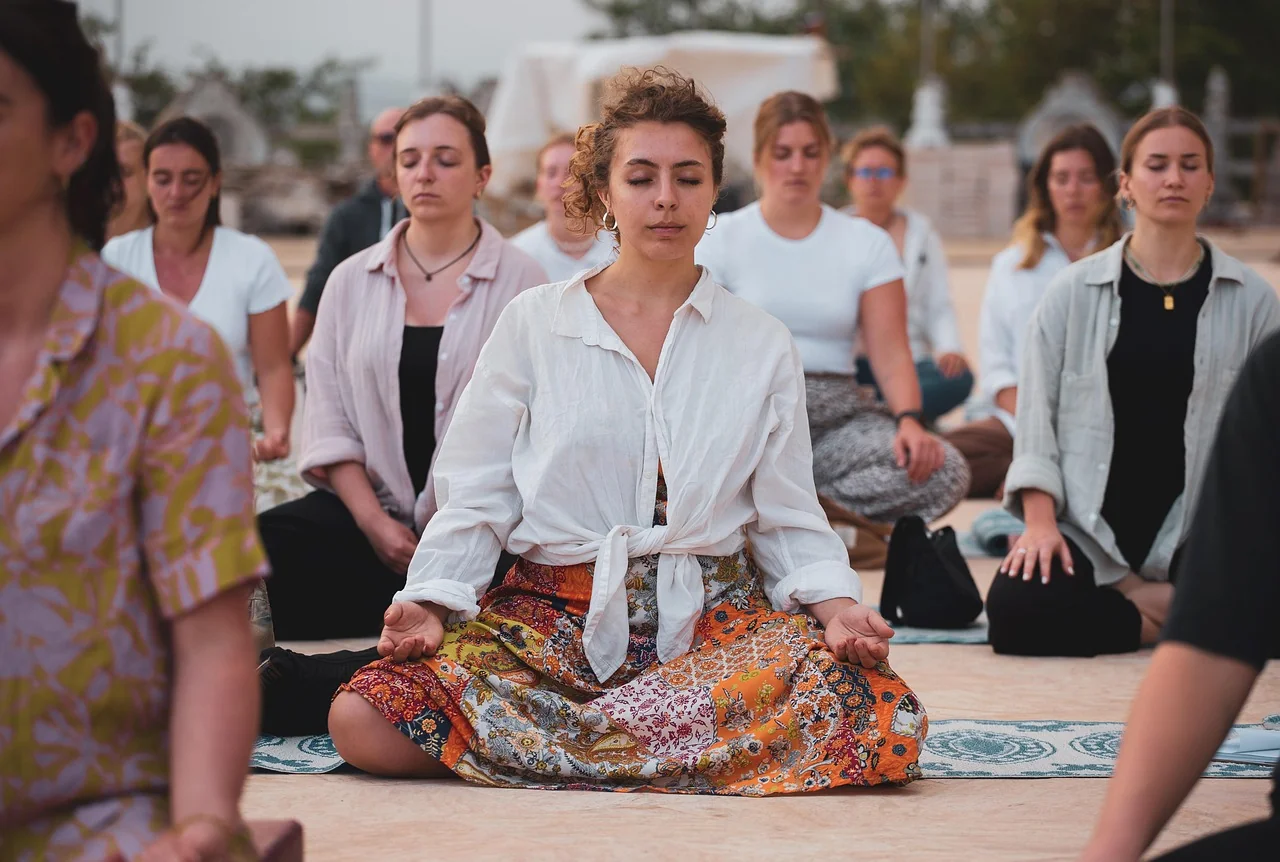Feeling that familiar knot in your stomach, the racing thoughts that won't quiet down, or a constant state of being "on edge"? You are far from alone. In our fast-paced world, stress and anxiety have become unwelcome companions for many, making the search for effective ways to decrease stress and anxiety more important than ever. But what if you could move from simply coping to genuinely thriving? This guide is your first step. We’ve moved beyond generic advice to bring you a powerful toolkit of actionable strategies, rooted in the calming practice of meditation and supported by practical lifestyle shifts. In the following sections, you’ll discover everything from immediate breathing techniques to quiet your nervous system to building a sustainable meditation practice that rewires your brain for calm. Get ready to reclaim your peace and cultivate a life that feels lighter and more in your control. Let's begin.
Understanding Your Stress and Anxiety
Stress and anxiety are your body's natural alarm systems. Stress is typically a response to an external trigger, like a looming work deadline or an argument. Anxiety, on the other hand, is often the body's internal reaction to that stress, characterized by persistent worry and fear that doesn't always go away after the stressor is gone.
You might experience:
- A racing heart or tightness in your chest
- Muscle tension, especially in your neck and shoulders
- Irritability and mood swings
- Difficulty concentrating or sleeping
- A sense of dread or constant overwhelm
These feelings are a normal part of the human experience, but when they become chronic, they can take a toll on your well-being. The good news is that your nervous system can be soothed. The following methods, particularly meditation, offer a powerful and proven path to manage these feelings and reclaim a sense of calm.
The Foundation: Mindful Breathing to Calm Your Nervous System
When anxiety strikes, your breath is the most powerful tool you have access to at any moment. Shallow, rapid breathing is a symptom of stress, but it's also a cue you can reverse. By consciously changing your breathing pattern, you can send a direct signal to your brain to activate the parasympathetic nervous system—your body's "rest and digest" mode.
This switch slows your heart rate, lowers blood pressure, and promotes a state of calm. It's the fastest form of stress and anxiety relief you can practice.
A Simple Breathing Technique to Try Now
The 4-7-8 method is highly effective for calming the nervous system quickly.
- Inhale quietly through your nose for a count of 4.
- Hold your breath for a count of 7.
- Exhale completely through your mouth, making a whooshing sound, for a count of 8.
- Repeat this cycle three to four times.
This practice acts as a natural tranquilizer for your nervous system. Use it before a stressful meeting, when you lie down to sleep, or any time you feel overwhelmed.
Cultivate a Daily Meditation Practice for Lasting Calm
While breathing is for immediate relief, meditation is the training ground for building long-term resilience. Think of it as strength training for your mind. Regular practice can physically change your brain, strengthening areas responsible for focus and concentration while calming the amygdala, your brain's fear center.
Studies show that a consistent meditation practice can lower cortisol levels, reduce symptoms of anxiety disorders, and improve your overall outlook on life.
Meditation Techniques for Beginners
Starting is simpler than you think. Find a quiet spot, sit comfortably, and set a timer for just 5-10 minutes.
- Focused Attention: Close your eyes and bring your attention to the physical sensation of your breath. When your mind wanders—which it will—gently guide it back to your breath without judgment. This is the core of many meditation techniques for beginners.
- Body Scan Meditation: Slowly bring your awareness to different parts of your body, one at a time. Start with your toes and move up to the top of your head. Notice any sensations—tingling, warmth, or tension—without trying to change them.
- Loving-Kindness Meditation: This practice directs compassion toward yourself and others. Silently repeat phrases like, "May I be happy. May I be safe. May I be healthy. May I live with ease." Then, extend these wishes to others.
A common hurdle is the belief that you must "clear your mind." The goal isn't to stop thoughts, but to become a more observant, less reactive witness to them. If you're new to this, a guide on meditation to clear the mind can be incredibly helpful.
Incorporate Movement: Mindful Exercise and Yoga
The connection between your body and mind is undeniable. Physical activity is a powerful outlet for metabolizing excess stress hormones like adrenaline and cortisol. It also releases endorphins, your body's natural mood elevators. The key is to engage in mindful movement, where you focus on the physical sensations rather than just burning calories.
Yoga for Anxiety
Yoga combines physical postures with conscious breathing, making it an ideal practice for calming anxiety. Certain poses are particularly grounding.
- Child’s Pose (Balasana): This resting pose gently folds the body forward, promoting a sense of safety and introspection.
- Legs-Up-the-Wall (Viparita Karani): This gentle inversion is profoundly calming for the nervous system and can help ease a racing heart.
- Cat-Cow Stretch (Marjaryasana-Bitilasana): This flowing movement synchronizes breath with motion, releasing tension in the spine and calming the mind.
Walking Meditation
If sitting still feels challenging, turn your daily walk into a moving meditation. Leave the headphones behind and focus on the rhythm of your steps. Feel the sensation of your feet connecting with the ground. Notice the air on your skin and the sights around you. Whenever your mind drifts, gently bring it back to the experience of walking. This transforms a simple activity into a powerful coping strategy for anxiety.
Create a Supportive Environment and Routine
Your external environment and daily habits play a massive role in your internal state. Creating a lifestyle that supports mental well-being is a crucial part of managing anxiety.
Digital Detox for Mental Clarity
The constant ping of notifications and the curated perfection of social media can keep your nervous system on high alert. Schedule regular breaks from your devices.
- Implement a "no phones in the bedroom" rule to improve sleep.
- Designate specific times to check email and social media rather than being constantly available.
- Try a full digital detox for a few hours on the weekend to reconnect with the offline world.
The Power of a Calming Routine
Structure can be incredibly soothing for an anxious mind. A predictable routine reduces the number of decisions you have to make, conserving mental energy.
- Morning Ritual: Start your day with 5 minutes of silence, a cup of tea, or journaling instead of immediately checking your phone.
- Wind-Down Routine: An hour before bed, create a relaxing ritual. Dim the lights, read a book, or practice your breathing exercises. This signals to your brain that it's time to shift into rest mode.
- Nourish Your Body: What you eat affects how you feel. Prioritize whole foods, stay hydrated, and be mindful of caffeine and sugar, which can exacerbate anxiety symptoms.
By integrating these ways to decrease stress and anxiety into your life, you build a comprehensive defense system. From the instant relief of a deep breath to the long-term resilience built through meditation for depression and stress and mindful living, you have the power to cultivate a life of greater peace and control. Start with one small practice today, and build from there. Your calm is waiting.
In summary, effectively managing stress and anxiety is an attainable goal through the consistent application of practical strategies. By integrating mindfulness practices like meditation and deep breathing, we can anchor ourselves in the present moment and disrupt the cycle of anxious thoughts. Furthermore, prioritizing fundamental physical health—ensuring adequate sleep, balanced nutrition, and regular physical activity—builds a resilient foundation for our mental well-being. It is equally crucial to establish clear boundaries, learn to delegate tasks, and make time for activities that bring joy and connection. Remember that these techniques are not a one-time fix but a toolkit for life. Progress is built through small, daily choices that collectively forge a path toward greater calm and control. Begin by selecting just one or two of these approaches that resonate with you, and take that first, empowering step toward a more peaceful and centered life. Your journey to lasting tranquility starts now.


